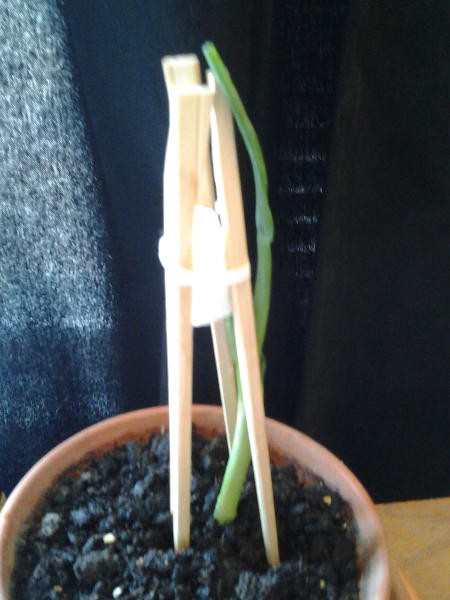I am altering the deal. Pray I do not alter it further.

Now I've got a bit of cotton stuck down the cut tube of the onion, and a wad of cotton on top of it (from little cotton pads I had; I'll have to pick up some actual cotton balls too, since the pads are kind of annoying), held up with chopsticks and twist-ties. Right now the cotton's just wet, since the tube has still got sugar syrup in it, but I'll add sugar to the water later.
Same onion. I figured I didn't want to leave it and see what would happen, since the top of the cut tube was shriveling. So I cut off the least healthy looking parts and decided to try this way to keep the cut-off end wet.
On the research end of things, I found this interesting paper, on making a lab-scale bioreactor for syngas to ethanol:
http://www.ndsu.edu/fileadmin/aben/SYNGAS_FERMENTER.pdf
A wood gasifier makes syngas from wood (and should be able to run on inedible straw and other agricultural waste). Because it works by partial combustion, it doesn't care about the cellulose/lignin distinction (lignin is the tougher part of wood, and a problem for digesters). This is an oldish technology that pops up on farms when oil, and therefore conventional liquid fuels, gets expensive, because it's actually fairly straightforward to convert trucks and tractors to run on it.
You don't need to run a fermenter to make ethanol from syngas (it's simple molecule, there are abiotic chemical pathways), but it's probably the easiest thing for a small operation.
So this might be the basis for a workable low-tech pathway from indiscriminate plant matter, which is abundant and easily stored, to fresh food. If you can make a wood gasifier out of mud and clay, and clay pot fermenters and other bioreactors, this could be really low-capital.
I wonder how hard it would be to fully feed people off of wood and straw, with simple equipment that can all be made with hand tools and fire, with starter samples of the right organisms, and maybe some cheap stuff like plastic sheets and staples...
Raising edible mushrooms and termites for chicken feed seem the simplest things. It's amazing what termites and fungus can eat. Can people live with mushrooms as a staple? Could they be happy with it? What else besides chicken and mushrooms do they need for a healthy and satisfying diet? Anyway, I'm drifting too far afield.
Wood to syngas to ethanol... then what can we feed the ethanol to, and how? What else can we feed the syngas to, and what can it make that's useful?
As I mentioned in the project summary, there are companies already developing industrial-scale commercial applications of methane or syngas to food (or at least to animal feed):
http://www.unibio.dk/what-is-uniprotein%C2%AE/
http://www.lanzatech.com/innovation/technical-overview/
This is important technology, with potential to increase the supply and lower the cost of food, and I'm glad to see it developed. But I also think that companies like this have an interest in limiting their technology to the large factory.
I'd like to see this sort of thing put to practical use on the individual and small-business scale, at a do-it-yourself level of complexity and unencumbered by patents. That way, it can develop faster and be used for more purposes.
 Darrell Johnson
Darrell Johnson
Discussions
Become a Hackaday.io Member
Create an account to leave a comment. Already have an account? Log In.